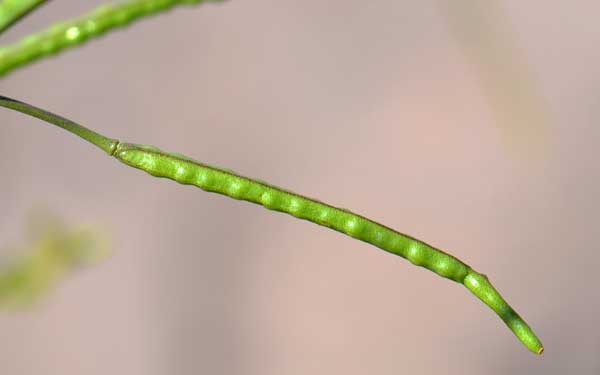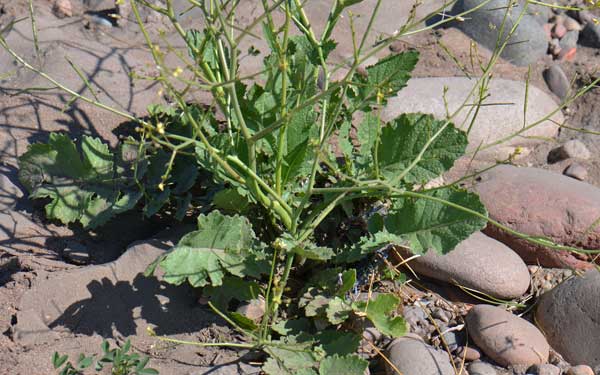Brassica tournefortii, Asian Mustard




Scientific Name: Brassica tournefortii
Common Name: Asian Mustard
Also Called: African Mustard, Desert Mustard, Mediterranean Mustard/Turnip, Moroccan Mustard, Prickly Turnip, Sahara Mustard, Tournefort's Birdrape, Turnip Weed, Wild Turnip; (Spanish: Mostaza del Sahara, Mostaza del Desierto, Mostaza)
Family: Brassicaceae or Cruciferae, Mustard Family
Synonyms: (Brassica tournefortii var. sisymbrioides)
Status: Introduced from Europe.
Duration: Annual
Size: Up to 2 ½ feet or more.
Growth Form: Erect, large basal rosette, stiff hairy pubescence, upper stem with slender green branches, heavily branched.
Leaves: Green; dramatic lush basal leaves with petioles, stiff hairy, lobed and serrate; upper stem leaves few.
Flower Color: Yellow; 4 petals, 4 sepals; 6 stamens, 4 long, 2 short, fruit is a long rounded capsule, a silique, narrowed between seeds, seeds drop into the soil and have the ability to survive fire.
Flowering Season: January to June.
Elevation: Under 2,500 feet.
Habitat Preferences: Disturbed areas, along roadsides and cultivated farm land.
Recorded Range: Asian Mustard is an introduced species in CA, NV,AZ, NM and TX. In Arizona it is found in the southwest corner of the state.
North America & US County Distribution Map for Brassica tournefortii.
U.S. Weed Information: Brassica tournefortii is listed by the state of California; California Invasive Plant Council (Cal-IPC), 2006, California Invasive Plant Inventory. Plants included here may become weedy or invasive.
Invasive/Noxious Weed Information: Plants in the genus Brassica are listed as a Noxious Weed by the state of Michigan.
USGS Noxious Weed Information
Michigan, Brassica, Mustard, Noxious weed.
Wetland Indicator: No data available.
Threatened/Endangered Information: No data available.
Comments: Asian Mustard is a European invasive first reported in the Yuma, Arizona area by Charles T. Mason in 1960. Its presence competes with, and displaces native plants. Asian Mustard is an aggressive low elevation weedy plant found in agricultural areas and beyond in the Sonoran, Sahara, and Mojave Deserts. In southern California it has invaded the hot inland valleys such as the Coachella and Imperial Valleys.
It appears that population centers of this abundant invasive weed appear limited geographically to isolated pockets of warmer areas in the southwestern states. It is similar in appearance and habitat to Indian Mustard, Brassica juncea. Although the leaves of Asian Mustard contain stiff rough hairs, leaves of most species of Brassica are reported to be palatable.

